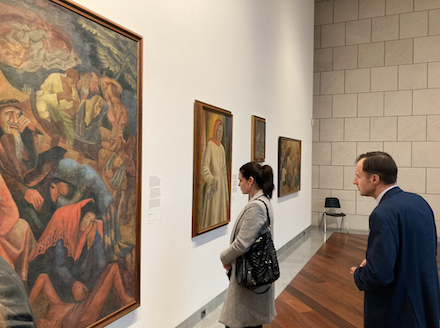Just before Russian missiles rained down on Kyiv and several other Ukrainian cities in November of last year, two trucks raced out of the capital and sped towards the border with Poland. Inside were dozens of valuable artworks, which were prepared for transport by staff so they would not be damaged, or worse, destroyed in the throes of the largest conflict on European soil since the Second World War.
Those works are now on display in Brussels, until 28 January, at the Royal Museums of Fine Arts as part of the exhibition titled In the Eye of the Storm: Modernism in Ukraine, 1900-1930s.

The exhibition includes more than 50 works from Kyiv’s National Art Museum and its Museum of Theatre, Music and Cinema, and is set to travel to other European capitals next year. When it debuted in Madrid in 2022, Ukrainian president Volodymyr Zelensky addressed the crowd through a pre-recorded video message from Ukraine, describing the show as “a vision of what Russia is trying to destroy”.
The works on display, all dating between 1900 and 1930, paint a picture of a flourishing arts scene that saw Ukraine’s creatives attempt to articulate a common identity against the tumultuous backdrop of collapsing empires, the First World War, the country’s struggle for independence and the creation of Soviet Ukraine.
“There are quite a few parallels between now and 100 years ago,” Katia Denysova, a London-based art historian whose research focuses on 20th-century art in Ukraine and one of the exhibition’s curators, tells The Parliament.
As well as offering a lesson in European art history, the show serves two purposes. First, it paints a vivid picture of Ukraine’s cultural heritage while keeping the world’s attention on the current situation. Secondly, it provides a way for the works to be kept safe while the war continues.
After Brussels, the exhibition will travel to Austria to be shown at the Belvedere Museum in Vienna from 23 February to 2 June. The next stop will be the Royal Academy of Arts in London, where the works will be on display from 29 June until 13 October. It’s unclear what will happen after that. While the curators are looking into storage options within the European Union, or an extension of the show, the decision will ultimately fall to Ukraine’s Ministry of Culture.
In recent weeks, Russian missiles have caused severe damage to several of Ukraine’s leading arts and culture venues, including the Odesa Fine Arts Museum, housed in a building that is more than 120 years old. Before the war, the institution hosted some 10,000 pieces of art, including paintings by well-known Russian and Ukrainian artists of the late 19th and early 20th century. “We’ve all seen what’s happened with Ukrainian heritage in Ukraine; it’s being targeted by Russian forces,” says Denysova. “Our project is an exercise in cultural diplomacy,” she adds.
While its timing has given the exhibit added gravitas, the idea for it developed a few years before Russia’s invasion of Ukraine. Konstantin Akinsha, a Ukrainian art historian who lives in the United States and is another of the exhibition’s co-creators, says European leaders were “absolutely unresponsive” to the idea when he pitched the exhibit before war broke out. “But when the war started,” he says, “I was ready to do it by myself if the governments were not going to. There was no safe space for anything, including art.”
While an exhibit can take years to put together under ordinary circumstances, Akinsha explains the modernist art show came together in less than six months as it was “a race against time”. “It’s more or less a miracle,” he says.
The artworks on display bring together different styles, from figurative art to socialist realism, cubism and constructivism. Several pieces by avant-garde artist Kazymyr Malevych are also on view. His inclusion in the show also doubles as a political statement – while he’s been defined as a Russian artist in art history books, he was born to Polish parents in Ukraine.
Several other artists featured in the show share similarly multinational backgrounds. The curators sought to reflect this multiplicity in the show’s title. “Modernism in Ukraine” is designed to highlight the pluralism of the artists on view and the period during which they made their art, in a way that “Ukrainian modernism” couldn’t, they explain. Several prominent female artists are also featured, among them Sarah Shor and futurist Alexandra Exter.